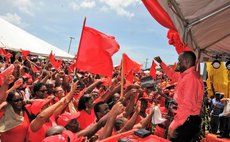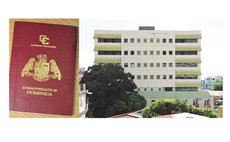Remembering the lessons that Hurricane taught Dominica
Two weeks from today, Monday, August 29th 2016 is the 37th anniversary of Hurricane David. Although it can be said that the physical and psychological scares of this devastating storm have somewhat healed (but the wounds were reopened by Tropical Storm Erika on 27 August last year) we also believe that Dominica has not effectively learnt the lessons that it should from the ordeal. Some persons believe that the island is still as vulnerable as it was on August 29th 1979.
On that day, one year after the island attained political independence from Britain, David, a Category Five hurricane packing winds of 150 miles per hour and carrying millions of gallons of rain slammed into the island. Unlike TS Erika, Hurricane David striped trees bare from our mountains and smashed homes to smithereens. After pounding Dominica for more than six hours, 56 people were dead, more than 180 injured and 75 percent of the population were homeless (Wikipedia). For many months after the hurricane, hundreds lived in tents or lodged with more fortunate friends.
Most significantly, Dominica's economy was virtually swept away by the winds of David. Roads and bridges were destroyed and on Dominica's farms, almost every banana plant was broken and coconuts and other fruits littered the ground. Thankfully, many countries came to the aid of our distressed country. After two months, the Interim Government of Oliver Seraphine announced that it had received pledges of US$37 million mainly from the United States, Britain, Canada and Caribbean countries. Apart from the physical damage, one of the more lasting impacts of Hurricane David was the massive exodus, in the wake of the storm, of the country's human recourses especially young, educated and trained members of the work force. That impact on the country's human resource base is still being felt 37 years later.
The point we need to stress here is that given the severe pain that David caused (and Erika repeated 36 years later), and the generally high cost of natural disasters, one would expect government and the population generally to plan more adequately because we do not exaggerate when we say that the threat of being devastated by another major hurricane (or Tropical Storm, for that matter) is as real as Dominica's green mountains and swiftly running rivers. And if there are any doubts about the vulnerability of Dominica and other Caribbean islands to hurricanes, just ask the people of Grenada, the Dominican Republic, Haiti, Jamaica and Cuba. Over the past few years hurricanes have destroyed the economies of these countries. Traumatized by potentially deadly hurricanes, the natives of these countries now live in fear every season.
Based on discussions with persons who are familiar with the state of Dominica's preparedness we have concluded that though Dominicans are definitely more aware of the occurrence and consequences of hurricanes due to the mass media and the Internet, the country is, arguably, as underprepared for a major disaster as it was in 1979.
Firstly, the Dominican economy was in a better position to recover from the shock of Hurricane David than it is today because bananas were the major crop at that time and bananas recover much faster than tourism after a major disaster. Additionally, in the post -David period financial aid, such as grants or loans at concessionary rates, were readily available. Today this facility has practically disappeared. There are also concerns about inadequate and high cost of insurance coverage for the tourism and agricultural sectors.
But if this is any consolation, the other islands of the region are in the same predicament. An assessment prepared a few years ago by the United Nations Development Programme (UNDP) and the Caribbean Disaster Emergency Response Agency (CDERA) revealed that there were serious shortcomings in the preparedness and emergency responses of the entire Caribbean.
Among the areas needing upgrading were disaster shelters, early warning systems and improvement in the levels of cooperation between the public and disaster management agencies. The study concluded that the region needed a comprehensive disaster management policy, including the provision for economic instruments and risk reduction strategies, hazard mapping and the storage of emergency supplies.
While on that subject, the government of Dominica needs to be complemented for including in its 2016/ 2017 budget the establishment of a vulnerability, risk and resilience fund to assist the country in building some level of "resilience in self-financing, rehabilitation and recovery, after disasters and external shocks" as the budget presentation stated. The Eastern Caribbean Central Bank (ECCB), the IMF and the Caribbean Development Bank should insist and persist until that facility is up and running. That facility is probably 40 years overdue.
As we observe the anniversary of Hurricane David and as we watch the progress of another hurricane season, there are a number of questions that we need to ask of our local and national authorities. These include: are the plans of the Ministry of Agriculture adequate for dealing with the eventual scarcity of food supplies after a storm? Are communities being sensitized to the fact that roads may be destroyed by landslides and that damage can be averted if they clean drains and gullies? Are schools, police stations and other public buildings adequately maintained to minimize the impact of hurricanes? Are Dominicans and the government saving enough to help finance a rehabilitation effort after a storm?
The point we need to stress here is that we are all aware that hurricanes are extremely dangerous weather systems and it is therefore grossly irresponsible for the population of Caribbean countries to take them so lightly. David should have taught us that lesson. That monster hurricane, David, of more than three decades ago, cannot be forgotten.




